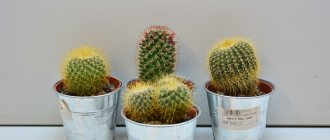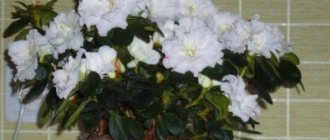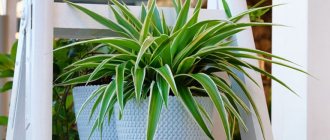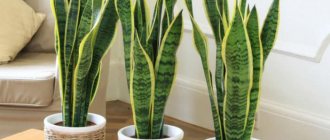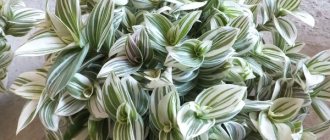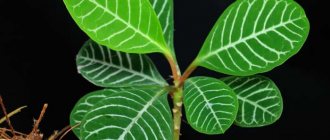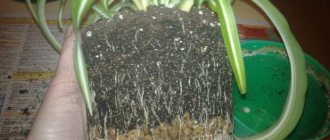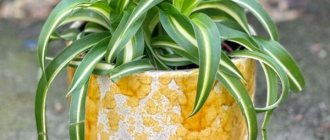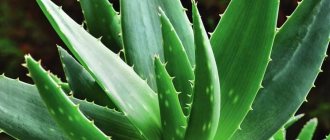Indoor flowers such as chlorophytum are called plants for lazy people. It can remain unattended by its owners for a long time, reproduces easily, rarely gets sick, and stands anywhere - in the back of the room or on the kitchen windowsill. The popularity of the culture is added by its attractive appearance, the ability to effectively purify the air, and the fact that caring for chlorophytum will not seem difficult even for a beginner. The only problem is that cats love the flower. If an animal gets to the plant, it will definitely chew off the leaves, and it will look sad.
Description and other names
Chlorophytum is a genus of herbaceous perennial plants that unites about 200 species. Previously it was included in the Liliaceae family, now it is classified as Asparagus. The homeland of chlorophytum is the humid subtropics of South Africa. Some species are common in Australia and southeast Asia.
Chlorophytum literally translates to “green plant.” The flower is often called spider lily, sedge, bridal lily, viviparous corolla, green lily.
Most species of chlorophytum in nature behave like epiphytes, growing on large branches of trees in the subtropical forest. They cling to the bark, receive water from precipitation, and nutrition from photosynthesis and air.
The root system of chlorophytum allows you to store a sufficient supply of moisture and plastic substances to survive an unfavorable period. Even in cultivation, with uneven watering, the fibrous shoots thicken, become translucent, juicy, and pearl-colored. And they grow overgrown with their own thin roots, extracting water and nutrition from the substrate.
They should not be confused with modified stems - tubers, bulbs, etc. In biology, such formations are called root cones, which are mistakenly compared by amateurs to potatoes. In fact, the underground part of the plant is similar to dahlias, buttercups, and clivias.
The leaves of Chlorophytum are succulent, soft or moderately hard, usually linear, lanceolate, sessile, rarely (Chlorophytum amaniense) - oval, petiolate. The tip of the plate is always pointed. The length, depending on the type and variety, is 15-60 cm.
The central vein is thick, depressed on the front side, convex on the back. Because of this, the sheet folds slightly inward along the central axis, but not necessarily.
In species or varieties with not too long, relatively wide plates, they bend slightly. Belt-shaped, narrow, they first rise in an arc above the pot of chlorophytum, then fall, and can be smooth or curled to varying degrees.
Leaf color is all shades of green. There are many varieties with white, less often yellow or cream longitudinal stripes; the name of the variety often depends on their placement.
Chlorophytum leaves are collected in an elegant rosette. There is practically no stem, in species X. The winged one is short and orange, as are the petioles of the wide oval plates. Over time, without division, the aerial part will grow and can become quite voluminous, since the root cones are capable of producing buds (eyes) at the end.
If caring for chlorophytum at home is at least satisfactory, there is enough light, most species regularly produce flower stalks. Their size is 0.8-1 m, but can be longer or shorter, their color is green, light green, yellowish or whitish. In some species the bud-bearing shoot is short.
After the flowers wither, daughter rosettes form in their place. Gradually, the children of chlorophytum become larger and grow swollen aerial roots, which, when they come into contact with the ground, quickly grow.
Many flower stalks emerge from an adult bush. Under the weight of the daughter rosettes, they hang down and form a cascade of several waves of green or white-striped tufts.
Pests and diseases of flowers
The appearance of pests and dry and yellow leaves on the plant are all consequences of mistakes in caring for chlorophytum.
Why does chlorophytum turn yellow?
There may be several reasons for yellowing leaves:
- Gradually, the leaves turn yellow due to a lack of nutrients in the soil or the pot for the plant is already too small.
- The foliage on the flower turns pale and yellow if the chlorophytum does not have enough light.
- Overmoistening of the soil can be another cause of yellowing of leaves . If the fleshy roots are kept in damp soil all the time, they begin to rot, causing the foliage to turn yellow. In this case, the bush must be pulled out of the ground, the rotten roots must be cut off, and the remaining ones must be sprinkled with crushed coal. After this, the plant is transplanted into a new pot and watered as needed.
Chlorophytum leaves drying out
Dry leaf tips may indicate dry indoor air or an excess of sodium in the soil. Review your care, spray the foliage if the room is hot and look at the composition of the fertilizer you feed the flower with.
If the leaves turn yellow and dry, carefully inspect them for harmful insects. Among the pests that can settle on chlorophytum are mealybugs, spider mites, aphids, nematodes, and thrips. They are destroyed using special insecticidal preparations.
Leaves turn pale and fall off because the plant does not have enough light or is too hot.
Brown wrinkled leaves indicate frequent drying of the soil.
Brown spots on the leaves are the result of frequent or too much watering in a cool room.
You will be interested to know: Caring for syngonium at home, photos and types, reproduction
Chlorophytum bloom
In nature, the plant blooms twice a year. At home, in the “right” pot, with good lighting, buds form in spring or early summer. There is no smell.
Many people believe that chlorophytum flowers do not have any special decorative value, but they are quite pretty.
The bud-bearing shoots of the plant are divided at approximately equal intervals into clusters that produce branches with several, usually from 2 to 10 white or greenish flowers. They look like stars with six rays and consist of two three-petal corollas inserted one into the other - the outer one is significantly larger than the inner one.
Chlorophytum flower stalks hang for a long time. The buds open gradually, first on clusters located close to the base of the bush. After about a month, daughter rosettes begin to form.
It will take a long time to wait until these stems dry out on their own. Usually they are pruned by their owners:
- if you don’t like the daughter rosettes hanging in a cascade, when the buds fade;
- to get an ampel or plant you need to propagate - after separating the children.
The flowering of Chlorophytum winged differs from other cultivated species.
The fruits are oblong tricuspid capsules. At home, they do not always ripen - flower stalks may disappear earlier. And there is no particular point in collecting them - from the seeds collected from the striped variety, you can grow chlorophytum with smoothly colored green leaves.
Safe for children and animals
The plant is absolutely harmless. Chlorophytum is not poisonous and does not emit allergens, so it is suitable for landscaping children's rooms and any educational institutions. The flower is not only safe, but also very useful. He is a real record holder for absorbing toxins and harmful substances.
Young children may taste the flower out of curiosity. Although this will not cause serious harm, it is better to protect the child from contact with the plant. Chlorophytum leaves are relatively hard, so there is a possibility of injuring the delicate baby skin.
The flower is not a dangerous plant for animals. Chlorophytum juice does not contain poisons. Many cats use the leaves of this flower to cleanse their stomachs, causing them to vomit. There is nothing wrong if pets sometimes bite off the leaves of the plant. For him, this only threatens decorative damage.
Useful and harmful properties
The flower is one of the best air purifiers for formaldehyde, with an effectiveness rating of 7.8 out of 10. NASA studies have shown that it absorbs carbon monoxide. This can be used in offices or apartments to control tobacco smoke.
Due to its high adaptability to unfavorable conditions, chlorophytum feels good even in the kitchen, where not every indoor plant can survive. It almost does not react to unstable temperature or humidity, frequent ventilation.
The benefits and harms of chlorophytum have yet to be fully studied, but the negative properties of the plant have not yet been identified. But the positive qualities are known:
- juice kills harmful microorganisms, including viruses;
- 4-5 chlorophytums can completely clean and humidify the air in a small room;
- cats readily eat the plant instead of special grass;
- green color calms the nerves.
Benefits for people
Chlorophytum gives off most of its beneficial properties when watered. Taking in moisture, the flower releases air enriched with phytoncides into the room. And this is very useful for people who have pulmonary pathologies. The plant is also useful for planting for allergy sufferers and people who often suffer from colds.
Another useful property of the plant is to absorb ammonia, nitrogen, formaldehyde, acetone, and carbon monoxide. Therefore, it is very difficult to do without such a plant if a person lives near the roadway.
Types and varieties of chlorophytum
The plant is widely distributed in culture. Chlorophytum in the interior does not take up much space, suitable for any room, kitchen, light bath. Most flower growers are familiar with only one species - Crested or its many varieties. But other chlorophytums can also be grown as indoor flowers, they are beautiful and unpretentious.
Crested
Chlorophytum comosum grows in southern Africa and was introduced and established in western Australia. In cultivation it is a low, lush rosette of basal leaves. In the photo, Chlorophytum crested often resembles a fountain of green, first rising in an arc, then thin belt-like plates flowing down. Their length and width are up to 50 and 3 cm, respectively, the tip is sharp, the edge is smooth, the central vein is clearly defined, the lateral veins are almost invisible.
The species chlorophytum is green; varieties and varieties may have light longitudinal stripes.
The socket is symmetrical. Fleshy thick root cones go into the ground about 10 cm, overgrown thin shoots go deeper.
Peduncles up to a meter long, flexible. From each cluster comes from 1 to 6 buds on stalks about 0.8 cm long. After wilting, daughter rosettes with dense roots appear on the tips, easily taking root when in contact with the ground.
Mandayanum
Chlorophytum comosum var. Mandainum is not a variety, but a variety, a variety of Chlorophytum crested. In botanical nomenclature, it is a minor rank above form but below subspecies.
It is more modest in size than the original komosum. The leaves are decorated in the center with a yellowish stripe.
Variegated (variegated)
Chlorophytum comosum var. Variegatum is another variety that is more common in culture than ordinary chlorophytum. The main difference is the two white stripes running along the edges of the plate.
The size of the bush is smaller than that of the species plant. But since the length of the leaves largely depends on the growing conditions, the difference often goes unnoticed.
Vittatum
This is already a variety registered in Holland, known since 1999. Not too attentive gardeners may confuse it with Variegata, but only if chlorophytums are not nearby.
Vitatum has one white stripe, running in the center, surrounded by a green color paler than at the edges. The plates are a maximum of 35 cm long, but wider than those of the species - up to 3.5 cm. They are more curved, and in young leaves they may even be slightly curled.
The peduncle of chlorophytum is pale, about half a meter long, and, depending on the lighting, has an orange or creamy yellow tint. The buds are greenish-white.
Curly (Bonnie)
Chlorophytum comosum bonnie is the most popular chlorophytum variety today. It is distinguished by a white stripe running along the central vein, the width depends on the light intensity.
The leaves are really curled downwards, as if large curlers have just been removed from them. Peduncles bend in a zigzag manner in all directions, the buds are white.
Ocean
The Ocean chlorophytum variety is less common than the previous ones. Along the edges of the plate there is a creamy white border, in the center there are uneven stripes of all shades of green.
The shape of the leaves is lanceolate, young ones grow more or less evenly, mature ones are curved, their length reaches 60 cm, width - no more than 2.7 cm.
Peduncles are dark green, branched. The buds are white-green, on a stem about 4 mm.
Atlantic
A Dutch variety of chlorophytum, registered in 2007. It is distinguished by a compact rosette with a diameter of up to 20 cm. In the center of the plate there is a wide white stripe with a pale green border; along the edge the color becomes much richer and darker.
The length of the leaves is no more than 25 cm with a width of 2 cm. The peduncles are cream or yellowish, 20-40 cm. The buds are collected in 1-4 pieces, white with a blurry orange tip.
Lemon
Chlorophytum variety, known since 2014. Leaves are up to 60 cm long with a cross section of no more than 2 cm. The color of the plates is uneven - from normal green to pale in one rosette. Often along the central vein there is a stripe that is a tone or two lighter than the main one.
The peduncle is green, curved, up to a meter. Each node contains from 1 to 4 lettuce buds.
Fungal diseases of Chlorophytum Lemon affect more often than other varieties. The tips of the leaves dry out more when there is insufficient air humidity or heat.
Winged (Orange, Orchidstar)
Chlorophytum amaniense or C. orhidasrum are the names of the chlorophytum species officially used in botany. Grows in the tropical undergrowth of eastern Tanzania and southeastern Kenya.
It is distinguished by a neat rosette of oval, petiolate, pointed at the tip and base, and not sessile, like other species, dark green leaves. The length of the plates reaches a maximum of 25-30 cm, width - 5-10 cm.
Short stem, grooved fleshy petioles - blurry orange or pinkish-yellow. The central vein is lightened, more so at the base than at the tip. The edge of the leaf is wavy.
Chlorophytum Winged forms peduncles emerging from the center of the rosette - short, similar to corncobs of pinkish or pale orange color. They are advised to be removed as early as possible in order to preserve the rich color of the petioles and stem.
Green Orange
Dutch variety, on sale since 2005. Elliptical, up to 20 cm long and 9 cm wide, the leaves are collected in a basal rosette.
The petioles (about 6 cm) and the central vein up to the middle of the plate are painted pale orange.
Fire Flash
Variety 2004. Leaves with a sinuous edge, dark green, oblong-oval, up to 30 cm long and 8 cm wide. The petiole (5 cm) and the beginning of the central vein are bright orange.
If chlorophytum produces a peduncle, the original color fades.
Cape
Chlorophytum capense is a less common species in cultivation. It is similar to the variegated form of Crested - white stripes run along the leaf up to 60 cm long and maximum 3 cm wide. But daughter rosettes do not form on the peduncles. The central vein is more depressed on the front part of the plate, protruding more strongly from the back.
Chlorophytum Cape is usually propagated by amateurs by dividing the bush.
Laxum
Chlorophytum laxum is a rare species in cultivation. It is distinguished by a dense rosette and narrow, up to 1.5 cm, lanceolate leaves decorated with white stripes. All sources indicate that they can reach 50 cm in length, but in practice they are much shorter. This is probably why in all the photos Chlorophytum Laxum looks like a plant with relatively wide plates.
The flowers are white, on short stems. After the buds wither, children are not formed.
Siam Lily
A popular variety, compact, with a neat rosette. The leaves are shiny, with two white stripes, 10-25 cm long, about 8 mm in cross section. The peduncle is green, 10-20 cm, buds appear in pairs at the nodes.
Lemon Lime
Chlorophytum Laxum variety of Indian selection, patent issued in 2007. The plant is distinguished by dark green, glossy, curved leaves with a yellowish edge.
Home care
Culture in content is one of the easiest for beginners or busy people. It forgives mistakes and inattention, while rarely reducing decorativeness, only slowing down growth. Even flowering depends more on the light rather than the care of the owners.
If you care for chlorophytum well at home, it will live for more than 10 years.
Temperature and lighting
The plant prefers partial shade or diffused light. It can stand in the back of the room, where a lamp is turned on nearby for several hours a day. If you do not provide at least short-term illumination, in the shade the area of white areas in varieties with variegated leaves quickly decreases, and green chlorophytums begin to get sick.
When the interior design requires the presence of a plant in a corner where even artificial lighting does not reach, a “shift method” is arranged:
- Chlorophytum is propagated to produce 4 identical flowers.
- One is placed in the shade, the rest are placed on a sunny windowsill.
- Every week, replace the plant suffering from lack of light with a new one.
This way the chlorophytum will not have time to get sick or even reduce variegated areas from lack of sun. And in 3 weeks it will fully recover and be ready to stand in deep shade for a while.
Often when describing a culture it is indicated that chlorophytum leaves can get burned in direct sun. This will probably happen with newly purchased delicate, stimulant-filled, Dutch greenhouse flowers. But when children propagate independently, the plants turn out to be persistent.
Landscape designers involved in landscaping in the southern regions often plant chlorophytums in sunny flower beds among flowering annuals. They look great, do not fade at all under the scorching sun, but, on the contrary:
- over the course of a season they grow into a huge bush;
- They let in a lot of babies, who manage to take root and develop a lush rosette.
So the burning of chlorophytum leaves in the sun is nothing more than a myth. Or flower growers confuse with it burns left by hot glass, the temperature of which under direct rays significantly exceeds what the thermometer shows. And it is almost impossible to prevent the leaves from touching the window - the chlorophytum bush is lush and spreading.
But, if the plant stood for a long time in poor lighting, and the owners immediately exposed it to the bright sun, the flower will definitely react. Dark spots will appear in the middle of the plate, which will no longer be possible to get rid of. Chlorophytum must be accustomed to direct rays gradually.
The plant feels great all year round at normal room temperature; in the summer it can live on the street or balcony and does not require special regimes. It is important to remove chlorophytum indoors in time before the temperature drops to 10° C or less. In heat of 30° C, the flower slows down its growth.
Variegated varieties or species need more heat and sun than those with smooth-colored leaves.
Requirements for watering and air humidity
In summer, irrigation is done abundantly, without waiting for the substrate in the pot with chlorophytum to dry out. In winter they are reduced, but not stopped. These are general rules for culture. You can even create a watering schedule:
- spring, summer - every 7-10 days;
- in autumn, winter - once every 3 weeks.
But if the owners go on vacation and there is no one to delegate to care for the chlorophytum, there is no problem. The plant can withstand drought well - the moisture supply is contained in thick, juicy root cones. Only young specimens with poorly developed lower processes can suffer from water deficiency.
Chlorophytum does not need regular spraying, nor does increasing air humidity by other means. Even in summer, it is enough to perform the operation once a week. In winter, you should not spray the plant, especially if it is kept cool. Water accumulates in the axils of the leaves, evaporation is slow, which will lead to chlorophytum disease - rotting of the base of the rosette.
The flower responds well to a warm shower in summer.
Feeding schedule
Many owners believe that it is not necessary to fertilize the crop - in nature, most types of chlorophytum get everything they need from water and air. Indeed, a flower without fertilizing usually does not lose its attractiveness, even if:
- not replanted annually;
- the roots fill the pot, stick out of the soil, or come out through the drainage hole.
But the decorative effect is still reduced, growth slows down, and flowering may not occur. If the shoot and buds have appeared, the children will develop poorly without fertilization and may begin to dry out before they have time to produce roots or reach a size sufficient for replanting.
Chlorophytum can be fed with any preparations for ornamental foliage plants:
- in summer - every 2 weeks;
- In autumn and winter, fertilizers are not given at all.
The tips of the leaves of chlorophytum dry out and turn black: what to do? (reasons and solutions to the problem)
Of course, chlorophytum is known as a very unpretentious flower. However, there is an unpleasant situation when the tips of the leaves of a recently gorgeous plant suddenly begin to dry out and even turn black. What are the reasons and how to cure your pet?
Causes:
- Watering is not organized correctly.
- Dense, unsuitable soil.
- Low temperature.
- Too frequent and unbalanced use of fertilizers.
Treatment methods:
- Transplant the plant into suitable, looser soil, and accurately select the size of the pot.
- Monitor the temperature of the water for irrigation. The water should be room temperature.
- Stop using fertilizers too frequently. If there is a suspicion of their incorrect use, replant the plant.
- Check air humidity. If the room is dry, cover the batteries with a damp cloth.
Features of transplantation
Young, actively growing chlorophytums can be replanted annually. Adult specimens need a new pot every 2-3 seasons, despite the rapid development and large volume of the root system.
The soil
Chlorophytum will grow even in heavy garden or garden soil, but it develops slowly and may refuse to bloom. A loose, light substrate with a neutral reaction is more suitable for the plant. We recommend the ready-made mixture “Universal” or “For decorative foliage”.
The soil itself is made from the following components:
- leaf soil - 3 parts;
- turf – 1;
- sand – 1.
Pot
The container for chlorophytum should be large enough - a powerful root system develops quickly. Any material, if the owners are confident that they will regularly replant.
Even in this case, the flower tends to grow to the walls. The root of chlorophytum has to be separated with a knife; sometimes it is easier to cut a plastic container or break a clay one to get out an earthen lump. It’s just a shame to spoil an expensive beautiful pot.
Many owners specifically plant the plant in a soft transport container and replant it only after it becomes deformed. Such a pot is cheap, it doesn’t hurt to cut it.
There must be drainage holes in the container. It is advisable that the side does not go inside - during transplantation, the root cones are injured when the owners take out the earthen ball.
Each time the chlorophytum is moved into a container 2-3 cm larger than the previous one. If you take a large pot, the development of the rosette will stop, and the flower stalks will not move forward until the flower entwines the clump.
Transplantation process
The operation is simple, but guaranteed to be done without damage only with young chlorophytums that have not had time to grow roots. When moving large specimens to a new pot, the underground part is almost always injured.
But experienced gardeners rarely bother to carefully handle the earthen clod. And in botanical gardens, when replanting, they often cut off the lower third of the roots with a sharp knife, and partially break out the side cones. This is done to reduce the volume of the coma, and immediately place the chlorophytum in the original container, adding fresh soil.
Transplantation according to all the rules:
- Take the plant out of the old pot. If necessary, run along the inner walls with the blunt side of a knife, separating the root.
- A container with a diameter of 2-3 cm larger is filled with drainage and a layer of fresh substrate so that the chlorophytum is at the same level as before.
- If necessary, dry or rotting shoots are cleaned.
- An earthen ball is installed in the center.
- Fill the voids with soil.
- They crush and water.
You need to care for chlorophytum at home after transplantation as before. Only the plant that was previously standing on a well-lit windowsill is briefly moved to partial shade.
Adapts quickly to light
Chlorophytum will not be scared by a change of habitat. The plant is able to adapt well to different conditions. It is enough to give him time to get used to it and not arrange a rapid relocation. Even if the adult flower was in bright light, the children separated from it for reproduction are quite shade-tolerant.
The plant will not withstand midday direct sunlight and continuous shade. Chlorophytum grows both in bright diffused light and in partial shade under natural or artificial light. The easiest way to determine its need for sun is by the color and growth of a flower.
Subtleties that should be taken into account when growing chlorophytum:
- bright lighting stimulates the active development of the plant; to slow it down, it is enough to place the flower in partial shade;
- in a shaded place, variegated varieties lose color. However, this will not affect the growth of the flower in any way.
Reproduction methods
Chlorophytum easily reproduces by daughter rosettes. The method is used even in industrial greenhouses, since an adult bush can give birth to dozens of young plants in a season.
A less productive, but fairly simple way is to divide the bush. Seed propagation is used only by breeders, or when a variety or species cannot be obtained in any other way.
Daughter sockets
If gardeners have enough patience, they can wait until the young chlorophytums attached to the peduncles form a large rosette of leaves and aerial roots 2-3 cm long. Then the plants can be separated from the stem and immediately planted in a light substrate.
The “tufts” of chlorophytum are attached to a flowering shoot on a short stalk. Those that reach the desired size can be cut off one by one without disturbing the small rosettes.
To speed up the process, experienced flower growers:
- Lower the peduncle to a pot with a light substrate. Press the daughter rosettes to the ground without separating them from the mother plant.
- Immerse the bases of the children in a container of water - there they will quickly sprout roots.
Dividing the bush
When transplanting chlorophytum, a large bush is divided into several parts with a sharp knife. Each should have a growing point and root cones. The wound surfaces are dried and sprinkled with crushed activated carbon.
Plant in a pot whose size is slightly larger than the volume of the root system. Water and care for it like an adult plant.
Seeds
This is the most difficult and unreliable way to propagate chlorophytum. If the seeds are collected with your own hands, the method is suitable for species plants, but not for varieties - the owners risk getting something unpredictable.
Sowing is done at the end of winter - beginning of spring. Chlorophytum seeds, pre-soaked for a day in clean water or a stimulant, are pressed into a wet mixture of peat and sand. Do not fall asleep, cover with glass or film. Keep at 21-25° C, ventilate daily, if necessary, spray with warm water.
When the shoots appear (after 3-6 weeks), they are gradually accustomed to fresh air. After protruding, 2-4 true leaves are dropped into plastic cups filled with light substrate. Plant in the usual soil mixture for chlorophytums when the plants become stronger.
Who needs to have a flower in the house?
It is useful to have such a flower at home for people suffering from asthma.
Chlorophytum cleanses rooms of negativity, protects against magical attacks, humidifies the air and destroys pathogenic organisms, so an indoor flower is a must-buy for people suffering from the following diseases:
- allergy;
- intoxication due to frequent contact with toxic substances;
- asthma;
- bronchitis;
- cold;
- fungal diseases;
- depression;
- prostration;
- weakened natural immune defense;
- neurological disorders;
- insomnia or frequent nightmares.
